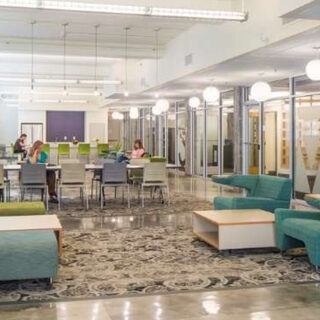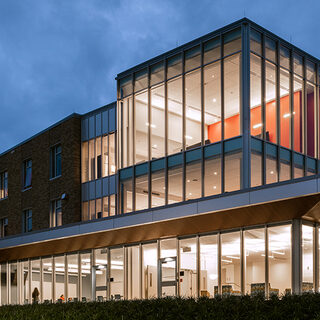Tradeline's industry reports are a must-read resource for those involved in facilities planning and management. Reports include management case studies, current and in-depth project profiles, and editorials on the latest facilities management issues.
Latest Reports
The How and Why of ‘Sticky Spaces’
The benefits of peer-based learning have led colleges around the country to devote spaces for students to study in groups. Designing these spaces so they actually attract students—making them “sticky”—requires providing the right mix for solo students and small and large groups; the furniture to accommodate them; amenities like ample white boards and well-placed coffee bars; floods of natural light; and ubiquitous access to power for recharging smartphones and laptops.
Grand Rapids Research Center
Michigan State’s GRRC provides research space for 33 principal investigators (PIs), in the domains of obstetrics gynecology and reproductive biology, translational science and molecular medicine, and pediatrics and human development. The program for the new building includes:
Creating Unique Research Facilities to Pursue the Newest Scientific Exploration
Most A&E teams will never have to plan the descent of a highly sensitive, one-of-a-kind particle accelerator a mile down a wet, dark, crooked shaft to an astrophysics research facility built in a decommissioned gold mine. Or collaborate on a strategy to acquire and store the equivalent of 20 percent of a year’s production of xenon gas without making a massive one-time purchase that could trigger a drastic spike in market prices. Or order equipment from around the globe that has to be transported by ship, rail, or truck because of the exposure to radiation in flight. The professionals who faced these challenges will probably not encounter them again on future projects. However, as scientific discovery continues to push the frontiers of the unknown, the need to create unique research environments is likely to become more frequent.
Energy-Efficient, Sustainable, Cost-Effective Facilities Start with Asking the Right Questions Early
Key questions asked during the planning process can drive the design of new and renovated research facilities, creating a high-performance, sustainable building with predictable operating costs. Questions from the building owner and stakeholders should focus on upfront costs, energy efficiency, long-term savings, safety, potential risks, construction materials, carbon reduction, zero waste, and performance vs. sustainability. For example: What energy efficiency measures should be explored? What safety strategies will have the most impact? What would it take to create a net zero lab?
42 Langguth Hall
Fairfield University has added a new residence hall to its campus, filling in the surrounding quad and providing students with modern amenities. The 65,000-sf 42 Langguth Hall houses primarily freshmen and sophomores in the Ignatian Leadership Residential College. The L-shaped facility houses 202 students—in 190 double rooms and 12 singles, plus three resident director suites. Fully accessible unisex bathrooms and showers are on floors one through three. The interior affords expansive open spaces and a spacious common area, with three floors of dorm rooms and a partial basement of supporting functions. The corner of the L is framed by a glass tower that connects to the quad and serves as a beacon.




